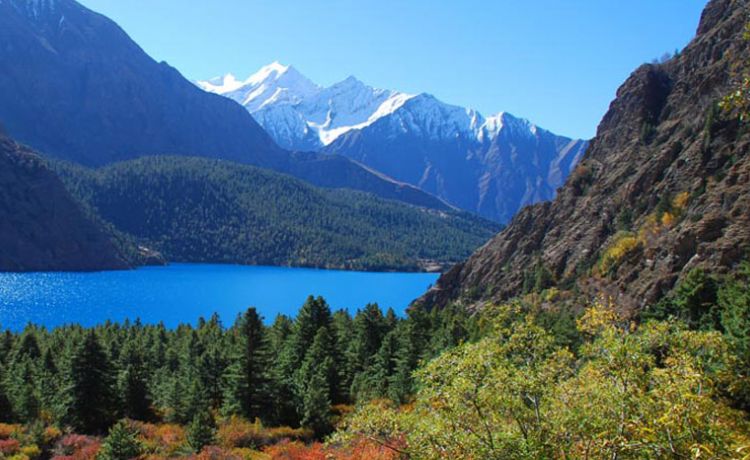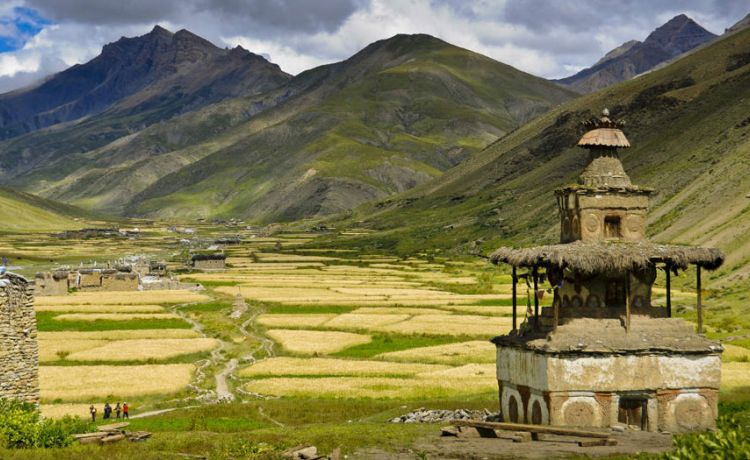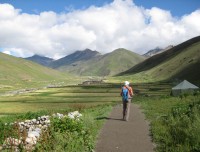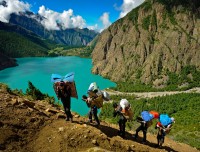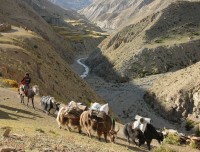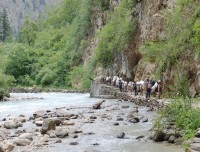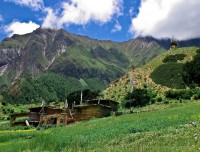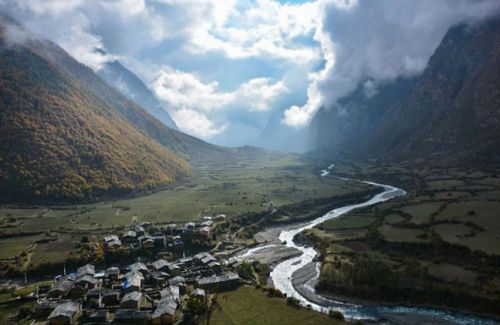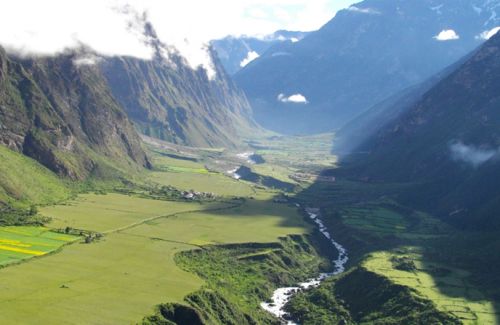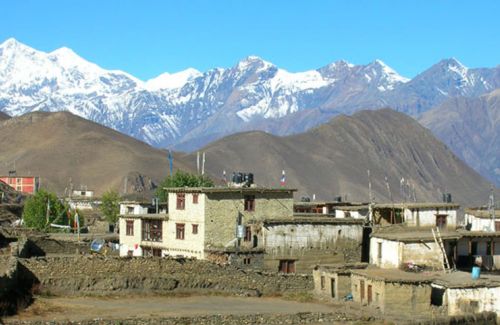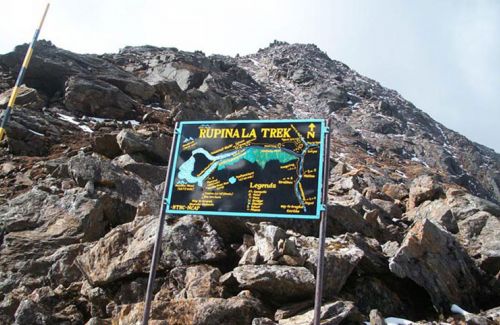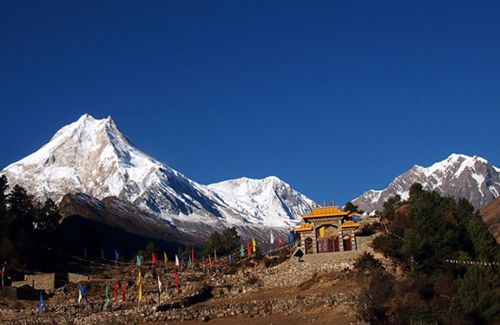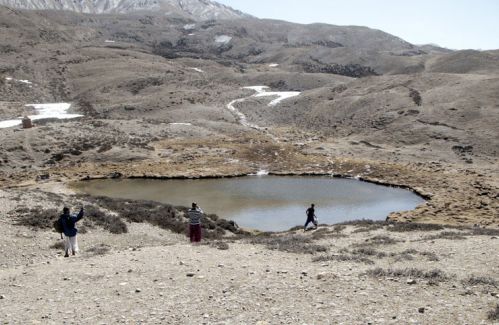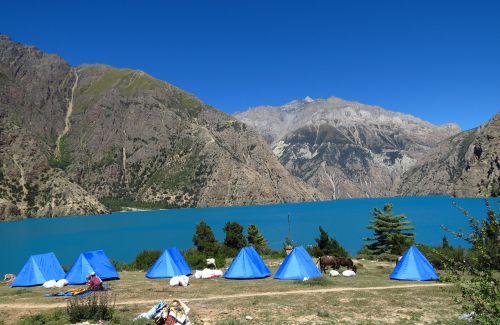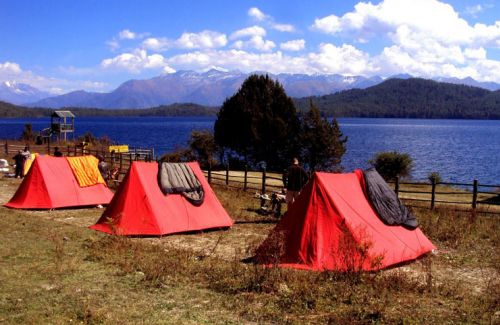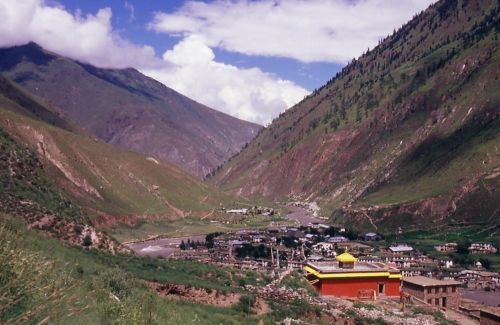Lower Dolpo Trekking
- Duration18 Days
- Max. Altitude5,070 m
- Starts FromUSD 1475
Destination:Nepal
Trip Grade:Strenuous (****)
Meals:Breakfast + Lunch + Dinner
Transportation:Private Vehicle / Aeroplane
Accommodation:Camping
Trekking Region:Lower Dolpo Region
Show All
Lower Dolpo has a rugged natural landscape. Lower Dolpo region is an area of mysticism. Dolpa is also called ‘Ba Yul’ or the hidden valley. Lower Dolpo is secluded and isolated from the outside world. Lower Dolpo trekking links Lake Shey Phoksundo with the natural beauty and cultural experience of Dho. There are altogether 130 Gompas in Dolpa. Shey Phoksundo National Park, Lake Phoksundo and Shey Gompa are the prime attractions of this region. The Lower Dolpa trek is one of the most famous trek as it visits Phoksundo lake, featured in Eric Valli’s Oscar nominated movie “Caravan”.
Phoksundo Lake also known as the Blue Lake, cuts one of the deepest gorges in Nepal but contains no aquatic life. People there practices the Pre-Buddhist religion called “Bon- Po”. The trail crosses the two high passes of Numa La (5,190 m) and Baga La (5,070 m). Kanjirowa(6,883 m) , one of the highest mountains in the region can be seen. The river Phoksundo flows south carrying the waters of Lake Phoksundo and falls via the Ganges into the bays of Bangal.
Blue sheep, musk deer, Ghoral, Snow Leopard, Himalayan Thar, Bear inhabit in the Shey Phoksundo National Park. So, Trek Lower Dolpo is to get the firsthand experience of ancient cultural traditions of Buddhists called Bon Po. The local people still dress in religious and traditional costumes during times of feasts and festivals. Dolpo region trekking makes anyone to realize how rich Nepal is in medicinal plants of various kinds.
Trip Highlights
- Full day sightseeing at UNESCO World Heritage Sites in Kathmandu
- Fly from Kathmandu to Nepalgunj, and then to Juphal
- Fly back from Juphal to Nepalgunj and then to Kathmandu
- Incredible rugged natural landscape
- The land of great mysticism
- The Shey Phoksundo Lake
- 130 ancient Gompas with their traditions
- Rich in Himalayan herbal medicines
- The high passes like Baga La, Numa La
- Rich in alpine vegetation and wild lives
Day to Day Itinerary
Day 01:Arrival day in Kathmandu (1,350 m) and transfer to the hotel
Day 02:Kathmandu valley sightseeing & Trek preparation
Day 03:Fly from Kathmandu to Nepalgunj & Transfer to Hotel
Day 04:Fly from Nepalgunj to Juphal/Dolpo (2,320 m), trek to Dunai (2,850 m), 2-3 hrs
Day 05:Trek from Dunai to Tarakot (2,543 m), 5-6 hrs
Day 06:Trek from Tarakot to Laini (3,160 m), 6-7 hrs
Day 07:Trek from Laini to Nawarpani (3,545 m), 5 hrs
Day 08:Trek from Nawarpani to Dho Tarap (4,090 m), 7-8 hrs
Day 09:Rest Day at Dho Tarap for acclimatization
Day 10:Trek from Dho Tarap to Numa La Base Camp (4,440 m), 6-7 hrs
Day 11:Cross Numa La (5,190 m), and camp at Pelung Tang (4,465 m), 6-7 hrs
Day 12:Cross Baga La (5,070 m) and camp at Dajok Tang (4,080 m), 6 hrs
Day 13:Trek from Dajok Tang to Ringmo (3,600 m), 3-4 hrs
Day 14:Rest Day at Ringmo for a hike to Phoksundo Lake
Day 15:Trek from Ringmo to Shyanta (2,520m), 5-6 hrs
Day 16:Trek from Ringmo to Jhupal (2,320 m), 4-5 hrs
Day 17:Fly from Juphal to Nepalgunj then to Kathmandu
Day 18:Transfer to the International Airport
Detail Itinerary
Day 01Arrival day in Kathmandu (1,350 m) and transfer to the hotelUpon your arrival at Tribhuvan International Airport, in Kathmandu, our representative from Himkala Adventure heartily welcomes you and transfers to the hotel. You could feel the jet lag so that it is time to take rest after check in hotel and you could explore Thamel market in your leisure. Overnight in Kathmandu
Day 02Kathmandu valley sightseeing & Trek preparation After breakfast, we get ready for the guided city tour to the UNESCO World Heritage Sites in Kathmandu. First we head towards the Monkey Temple. It is called lovingly because there are about 460 monkeys living in this conical shaped hill. This is in fact very old stupa built in Tibetan architecture. The view to the adjacent hills and the valley view seem gorgeous if it is not smuggy. After this, we visit to Kathmandu Durbar Square where there we visit the Kumari House, Palace, courtyards, many Hindu Temples stone inscriptions and the museum. The third place, we drive from Kathmandu Durbar Square takes 8 km to the Boudha Stupa, the biggest stupa, in southern Asia, is full of spiritual vibration. The fourth place the famous Shiva Temple is about 2 km far from here. There we can see the cremation Ghats and many Hindu temples which have occupied 264 hectors of land and are really spacious. After the day tour, we return back to hotel and give you briefing about the Lower Dolpo trekking that we begin from the next day. Overnight in Kathmandu
Day 03Fly from Kathmandu to Nepalgunj & Transfer to Hotel We fly early in the morning from Kathmandu to Nepalgunj. It is 45 minutes flight. The scenic flight from Kathmandu to Nepalgunj gives us thrilling experience. After we land, we transfer to the hotel. Overnight at Nepalgunj
Day 04Fly from Nepalgunj to Juphal/Dolpo (2,320 m), trek to Dunai (2,850 m), 2-3 hrs It is 35 minutes flight from Nepalgunj to Juphal, then we start trek to Dunai which takes about 3 hours. After taking lunch at Dunai, we visit central gumba and the local people and try to understand their way of living, about their culture. Overnight at Dunai
Day 05Trek from Dunai to Tarakot (2,543 m), 5-6 hrs Today, we begin our trek along the south bank of the river heading upstream. We pass through the deep gorges, cross the hanging bridges and meet the lonely villages. The path seems unique, just seven meters high from the river, through the pine forest over the gorge. After a while, the beautiful village of Tarakot appears with its old fortress built by the Dzong, the local peope. This is the village situated on the hillock to the south of Bheri River. Overnight at Tarakot
Day 06Trek from Tarakot to Laini (3,160 m), 6-7 hrs After breakfast, we follow the trail that goes through the Tarap Chu River upstream. We cross the bridge over the Tarap Chu River twice. Then, we visit the Sandul Gompa at the junction of Barbung Khola and Tarap Chu River. The path traverses through the farmland and outlying countryside. The trail fluctuates and finally descends to Laini. Overnight at Laini
Day 07Trek from Laini to Nawarpani (3,545 m), 5 hrs Today, after having breakfast, we continue the path up to the gorge of Tarap Chu River. It goes high above through the steep slopes. The valley is really narrow and we pierce the gorge. After this, we descend to Chyugur Khola and cross the bridge. We then reach to Nawarpani. Overnight at Nawarpani
Day 08Trek from Nawarpani to Dho Tarap (4,090 m), 7-8 hrs After breakfast, we slowly ascend to Kamattarka where there is the confluence of the Tarap Chu and Lang Khola, a stream flowing from the east. We walk through the gorges and pass through juniper bush and wild rose. After 3 hours walk, we arrive at Dho Tarap, encircled by an irregular stone wall. This is the village, believed to be one of the highest human settlements of the world. Unique Bhotia culture, famous Buddhist and Bon-po monasteries are the prime cultural experience of this region. There are Ribumba and Jhampa Buddhist monasteries. The Siphok gompa is famous Bon Monastery. Dho village is important place for the cross border business between Dolpa and Tibet. Overnight at Dho Tarap
Day 09Rest Day at Dho Tarap for acclimatization Today, we take a rest and explore the village, do hiking and view the spectacular view of rugged terrain, green valley and pasture which give wonderful natural experience. We visit the monasteries and interact with the local people. Overnight at Dho Tarap
Day 10Trek from Dho Tarap to Numa La Base Camp (4,440 m), 6-7 hrs After an exotic stay at Dho Tarap, we continue to walk towards Upper Tarap Valley, following the plain valley with the grassy riverside. This further leads Tarap Chu River upstream all the way. Tarap Valley has owned its specialties with high mountains. After few hours walk, we reach to Tokyu village and we can see the monastery belonged to the Chiba sect. We, then climb up through the rough track to reach beneath the Numa La. It takes about 3 hours from the Tokyu village and we stay in our camp. Overnight at Numa La
Day 11Cross Numa La (5,190 m), and camp at Pelung Tang (4,465 m), 6-7 hrs The day is difficult and challenging. We continue the trek and cross the Numa La Pass at an elevation of 5,190 m. The track goes steeply up all the way to the top ridge of Numa La from where the great view of barren landscapes and Dhaulagiri (8,167 m) can be seen. After we reach on the top of Numa La and view around, we slowly descend down to the camp at Pelung Tang. Overnight at Pelung Tang
Day 12Cross Baga La (5,070 m) and camp at Dajok Tang (4,080 m), 6 hrs After breakfast, we again ascend steep to reach to Baga La at an elevation of 5,070 m from where the splendid view of Kanjirowa can be seen. After we take the miraculous view of the landscape and the snow capped mountains, we descend downhill to Dajok Tang. It takes about 3 hours from the top. Overnight at Dajok Tang
Day 13Trek from Dajok Tang to Ringmo (3,600 m), 3-4 hrs It is the fantastic day walk from Dajok Tang to Ringmo through pine forest. After a while, the vegetation changes from the pastureland to the alpine shrubs on the way to Ringmo. It is the decent slopes with few ups and downs and ultimately we arrive at Ringmo. Overnight at Ringmo
Day 14Rest Day at Ringmo for a hike to Phoksundo Lake This is the day to explore Ringmo and hike to the Phoksundo Lake. From here the yak caravans will be heading to the north towards Tibet Border. We visit the monastery at Ringmo and the village around. We hike to Phoksundo Lake and enjoy its serene beauty. Then we descend down to Ringmo. Overnight at Ringmo
Day 15Trek from Ringmo to Shyanta (2,520m), 5-6 hrs After breakfast, we trek down to Chepka. Then, the trail follows the big overhanging rock. After a while, the trail passes through the villages. We climb to Shynta from the village. Overnight at Shynta
Day 16Trek from Ringmo to Jhupal (2,320 m), 4-5 hrs After breakfast, we gently ascend to Sulighat passing tall birch trees. From the top of the ridge, we can view the mountains and Juphal below. We need to be aware while descending down to Juphal. After our arrival, we can explore the market and walk around. Overnight at Juphal
Day 17Fly from Juphal to Nepalgunj then to Kathmandu We fly from Juphal to Nepalgunj and take the second flight from Nepalgunj to Kathmandu. After arrival at the airport in Kathmandu, we then go the hotel and spend the rest of our time remembering those trekking days and. We get together in the dinner with Nepalese Cultural Show. Overnight at Kathmandu
Day 18Transfer to the International AirportYour trip to Lower Dolpo from Himkala Adventure ends today with great exaltation. We escort you to the airport 3 hours before to your flight schedule. You could spend time for shopping in the local market if you have enough time before departure otherwise; we leave you on airport with gratitude that you joined Himkala Adventure for the Lower Dolpo trek. We wish you have your safe journey to onward destination. Namaste!!!
Trip FAQ
Himkala Adventure would like to quench the thirst of all necessary questions answers about Lower Dolpo Trekking for all curious travelers/trekkers in the world. As you are entirely from different geographical location, you could better to know everything about the treks from the beginning i.e. airport pick up till your departure like airport picks up, drops off, accommodation in city, in the trek, guide and porters, safety for the trekking, food and accommodation and some other things that you might face on the way. Hope our endeavor listing these questions answers will help you self informed.
This is simply the outlines of the services we offer but it may differ as per your requirement, number of trekkers. What we go through our conversation, we will manage the means of transportation, hotels in the city, accommodation in the trekking, numbers of porters etc. This is general idea about Lower Dolpo Trekking before your trip and you become clearer about the trek. Please feel free to contact us to get more information about the trekking in the Himalayas of Nepal.
1) How is Lower Dolpo Trekking in Nepal?
Lower Dolpo Trek offers an outstanding trekking experience in the remote western region of Nepal. The Phoksundo Lake Trekking goes through remote locations admiring the beautiful rain shadow landscape of the Himalayas, glistening Phoksunda Lake, reflected in the colorful barren slopes of the mountains. This is also one of the few areas where the pre-Buddhist Bon Po religion is still practiced. While on the trek, we get to muse at the yak caravans that maintain the traditional salt trade with Tibet. We also cross two high passes- Numa La and Baga La-and reflect on life amidst the tranquil waters of Phoksundo Lake.
2) What physical fitness do I need to book this trip?
Every trekking in the Himalayas of Nepal require the certain level of physical and mental fitness.So, we advise you to be in good physical shape and able to feel comfortable while hiking up and down 7 to 12 miles per day on a trail carrying a day pack of about 10 pounds. Three things could make you confident enough for any trek you would like to do: aerobic, strength and mental.
Aerobic conditioning is important primarily because you will be trekking in thinner air, up to 40% less than at sea level. With good aerobic conditioning, you will be able to better metabolize whatever oxygen is available to you. You should plan on doing at least one hour of aerobic 3 /4 times per week for 1 month or more before your arrival in Nepal. Walking, jogging, cycling, hiking on valley floor to ridge line ascents with day back are some of the excellent forms of exercise, so long as you are strengthening leg muscles and building stamina. Speed is not the essence; stamina, confidence and continuity are.
3) How do I find Himkala Adventure for my pick up at the airport?
Our representative from Himkala Adventure will display a small board of company or with your name outside the airport terminal. You will be driven to the hotel by our tourist vehicle.
4) What sort of accommodation do I get in Kathmandu?
Normally we provide standard rooms with twin sharing accommodations at three star or similar category hotels in Kathmandu including breakfast. Accommodation in these cities can be upgraded as per your request. But some of our packages are sold without accommodation in the city.
5) How is camping trek during Lower Dolpo Trekking?
Camping trek to Lower Dolpo is fully organized and supported, with a team of guides, cooks, and porters to accompany you. Our porters carry all the trekking gear, food, fuel and personal belongings. Our cooks prepare hot meals. Trekkers need only carry a small bag as required for the day. At night, tents for dining, sleeping and ablutions tents are provided and set up, also mattresses and down-filled sleeping bags, tables and seating.
In a typical camping trek, we start the day around 6 a.m. with a cup of hot tea. You are then provided with a bowl of warm water for washing. Then trekkers enjoy breakfast before leaving camp. The trek begins around 7.30 - 8 a.m.Trekkers can set their pace for pausing and sightseeing and the walk to the lunch spot will normally take 3 hours. On arrival, you are served hot lunch. In the afternoon, after walking for another 3 to 4 hours, you arrive at the next camp around 5 p.m. Tea & snacks are served while our staff readies the camp. Dinner time is around 6/7 p.m. in the dining tent, lit with lanterns and comfortably furnished. The food is healthy, wholesome and hygienically prepared.
6) What mode of transportation do I use?
We will provide the private transportation for Airport/Hotel/Airport pick up and drop and sightseeing in Kathmandu Valley. We use transportation as based on our cost inclusion section. The transportation varies depending on your requirements at the time of booking the trip.
7) What is the best season for this trekking?
The best season for Lower Dolpo Trekking is spring (March to May) and autumn (September to December). These are the perfect time of the year for the breathtaking views of Himalayas with clear and sunny days. But the weather in the mountains is unpredictable.
8) What is the weather and temperature like during the trekking?
The climate in Nepal varies from place to place which can be categorized in different four main seasons. The main seasons in Nepal are spring (March to May), summer (June to August), autumn (September to November) & winter (December to February). The best season to travel in Nepal is autumn (September, October & November) & spring (March, April & May). Weather in the mountains is unpredictable. But the day temperature in Lower Dolpo Trekking is comfortable.
9) Who will be guiding me during this trip?
We provide the professional government license holder English speaking trekking guides for our entire trekking trip. We can also provide French, Spanish, Japanese, German or Italian speaking guides as per your preference with extra payment but not guaranteed. All guides will be Nepali people who are carefully selected on the basis of their appropriate experience, leadership skills and personality. They are all trained from Nepal Academy of Tourism and Hotel Management, certified and approved by the Tourism Department of Nepal government. We provide a different city tour guide to guide you in UNESCO World Heritage Sites in Kathmandu. They are the professional license holder guide specialized in culture, history, geography, iconography, archeology and religion with good command over English. Tour guides are specialized in city tour and trekking guides are more in the hiking and trekking in the Himalayas.
10) What sort of experience do your guides have?
Our entire city tour guides have bachelors to Master Degree academic education along with many months tour guiding training from Nepal Academy of Tourism and Hotel Management, Rabi Bhawan, Kathmandu, Nepal. They are fluent in spoken languages and informative about the sites in many aspects. They are quite experienced and dedicated to their job and responsibilities.
Our entire trekking guides have minimum Intermediate to Master Degree academic education with trekking guide training from Nepal Academy of Tourism and Hotel Management, Rabi Bhawan, Kathmandu, Nepal. Many of them are from villages. As they are local, they know more about the routes, necessary precaution to be taken and so on. They have spent many years exploring many parts of the country. They are trained in first aid and able to handle any situation easily. They speak good English and make you know about the places you visit.
11) May I charge my electronic devices during Lower Dolpo Trekking?
This is fully camping trek, so we may not be nearby any settlements. You could better manange extra battery or any other alternatives.
12) What is the social and environmental responsibility of Himkala Adventure for this trip?
The situation of environment in Nepal is in considerable stage due to so many factors caused by global warming, human activities, and adverse effects of natural incidents. Nepal is in between two giant countries like China and Nepal. The ozone layer is depleting and the atmosphere is getting heated. So, its direct effect is to the Himalayas that the snow is melting day by day and the sea level is rising. It is due to population growth, people are clearing the forest and the soil is being eroded. As a part of society, and our trekking related activities are directly concerned with the social and environmental things. We are very conscious not litter in the open spaces, to manage garbage properly and make local people aware in this campaign. We are working together with other companies and taking these issues seriously.
13) What is the minimum number requirement for this trip?
We operate individual trip to the group joining trips for Lower Dolpo Trekking. If you want to do any private trip we are ready to organize for solo traveler as well with some additional charges.
14) Are there communication or internet services during Lower Dolpo Trekking?
We highly recommend taking local SIM card for call and internet services during trekking. Local SIM cards are easily available in many stores and at airport as well. You need to provide two copies of your photographs and your passport copy to get local SIM CARDS of NCELL & NTC (only these two companies provide telephone services in Nepal
15) May I add extra days in trekking?
We are ready to operate your holidays as per your interest and requirements. You can spend extra days on your loving or favorable places or even can make it shorter. We will always do our best to manage your hotel bookings, flight booking and everything.
16) What happens in case of emergency?
Himkala Adventure has prepared for any emergency situation and knows how to handle it. Our guides are trained in first aid and can deal with most of the basic ailments that occur during the trek. Every client should have his own insurance before coming to Nepal for the case of emergency.
17) Do I need to have insurance for this trip?
We request you to have a travel-insurance policy to cover theft, loss, medical problem & emergency helicopter evacuation from high altitude places before coming Nepal. Choose a policy to cover your emergency high altitude helicopter evacuation with all medical insurances for trekking in high altitude in the Himalayas of Nepal. Your travel insurance is always needed before going in any high altitude trekking. Please check your travel insurance policy which doesn’t exclude mountaineering or alpinism. Although you will not be engaging in these activities in your trekking, you might have problem convincing the insurance company of this fact. Rescue insurance need to cover an emergency helicopter evacuation or a charted flight from remote mountain trails of Nepal as well as international medical evacuation. A helicopter evacuation might cost US$ 2500 to US$10000 depending on the places. So that travel insurance to cover all above is must to travel in the high Himalayas of Nepal
18) What type of shoes should I wear during Lower Dolpo Trekking?
You could better have carefully chosen hiking boots with extra laces and camp shoes, which should be kind of strong, well-made but light boots for Lower Dolpo Trekking. Shoes and boots are best to buy before arriving in Nepal. We advise you to wear your new shoes for sometime before trek so that you could feel well habituated on the newer trail for your feet.
19) Can I use credit cards in Lower Dolpo Trekking?
Of course not, you can use only in the cities like Kathmandu but not in Lower Dolpo Trekking route. When you are out of city, all you need is cash, better to have small notes. Please change the currency in local Nepali rupees before you go to the mountains.
20) Do I need to tip my guide and porter? How much would that be?
Tipping is not mandatory, neither it is right to ask by anyone but it is a way of showing gratitude after taking service. The level of tip also shows how satisfy you are from the team that you had been during your tour/trek.However, we recommend you to spend minimum 10% of your total trip cost for tipping entire local staffs, the ratio of tipping guide and porter will be given to you at the pre-trip meeting in Kathmandu before starting the trek.
Trip Note
Cost:
The cost of trip varies according to the number of travelers in the group, the category of the Hotel, mode of the transportation and any kind of changes (if there is). So, if you would let us know all of these above mentioned things, then we could quote you the exact price.
Essential Documents:
You are requested to send the following documents after you confirm or book the trip with Himkala Adventure:
A copy of your passport and travel/health insurance documents with contact details, three passport size photos.
It is advised to maintain a separate photocopy of all important documents including traveler’s cheques, bank/ATM card, contact numbers, international flight tickets, and emergency contact numbers.
Weather:
The main trekking season in Nepal is from October to December and March to May. The day temperature for walking to Lower Dolpo Trekking is comfortable. The sky is clear although there is snow and rainfall occasionally. It is about 10 degree centigrade at the height of 3,600 m and increasingly lower, the higher we go.
Extreme Weather and Airport Closures:
Weather conditions in the Himalayas are unpredictable. Flights can be cancelled or delayed due to bad weather. Flights to and from Kathmandu/ Nepalgunj/Juphal may get cancelled or delayed. There is no other alternative except having patience for the good weather or have some optional trip around or chartering helicopters. You will be accommodated at your joining hotel at your own expense.
Nepal Strikes:
There is much more progress in the political scenario in Nepal and we assure you that travelling in Nepal is safe. But there may be Bandha (wide transport strikes) at a very short notice. The shuttle bus is in operation by Nepal Tourism Board and the Nepal Tourist Police in conjunction with the Himalayan Rescue Association from domestic and international terminal to the various hotels in Kathmandu. The service costs 300 rupees per person.
Itinerary Disclaimer
Himkala has thoughtfully designed all the itineraries but our itineraries are updated for the betterment on the basis of our past travelers’ comments and our own research. In case you find changes in the itinerary you printed and the upgraded one does not affect your trip. Please note that some changes may occur in our itineraries due to bad weather and common seasonal changes to timetables and transport routes.
Physical Rating:
Your trip will be meaningful if you could find yourself fit and fine. You will be walking up to 5,070 m from the sea level. As the geographical region varies, there is a temperature variation as well. So, we advise you to undertake regular physical exercise, jogging, hiking, riding, ascending and descending the long stairs etc.
Group Size:
Himkala Adventure organizes solo to group travelers. Our group trips are designed for sharing accommodation and there is no single supplement. Single travelers share with the same gender from twin to multi-share in an accommodation. You are requested to have mutual understanding in between the fellow travelers who have joined from the different parts of the world. Please remember that you have great responsibilities in the group. If you are requested to be at a particular place at a certain time, make sure that you have been there at a time. It is much more pleasing sharing experiences and traveling together.
Accommodation and Meals:
Accommodation and Foods in the Himalayan region of Nepal cannot be compared with any developed countries in the world. We know that you might not have experienced such things before but you should take it easy. Accommodations at local lodges are simple but clean and comfortable. The food is plain. Toilets and washing facilities are shared and rudimentary. In high altitude regions, there are very few tea houses and one has to be happy to share in simple dormitories without electricity, without running water. Hot shower means a bucket of hot water upon our request.
Money Matters:
Please note that most establishments in Asia will not accept foreign currency notes that are old, torn or faded and they can be very difficult to exchange or extra fees added when exchanging at banks. Please ensure that you have new, clean notes.
The official currency of Nepal is the Nepali Rupee (NPR). ATMs can be found only in major cities of Nepal like Kathmandu, Pokhara, Chitwan, Bhaktapur etc. The government of Nepal has banned the import, export and use of 500 and 1000 Indian rupee notes in Nepal. You make sure that you won’t carry these notes upon arrival in Nepal, otherwise they are confiscated and you may be fined.
Please make sure that the foreign currency notes that you have are new and clean notes because old, torn or faded foreign currency notes in Nepal are very difficult to exchange or extra fees added when exchanging at banks.
While travelers cheques have security advantages exchanging them can be a lengthy process, commissions can be high (up to 10%) and they can be difficult to change in rural areas, on weekends and public holidays. If you choose to bring travelers’ cheques, make sure they are a major brand and major currency.
Tipping:
Tipping is not mandatory. It is not anyone’s right asking for tips but if you are happy with the service, you could tip the staffs. It is entirely a personal preference. Tipping could be significant to them who took take great care of you in your traveling period. Himkala recommends that you could tip any intended recipient by any member of the group than collected and passed on by the group leader.
Note: Please do not tip with coins or dirty and ripped notes. This is culturally taken as an insult.
Local Dress in Nepal:
Nudity is a sensitive issue in Nepal. Women should avoid wearing shorts and sleeveless tops in public places where this might be seen as inappropriate. Remove shoes before entering certain holy places. Non-Hindus are not permitted in some temples.
Feedback:
Your feedback will be the great guidance to meet our target and to bring improvement in our service. What and how have you experienced with Himkala Adventure and our staff? Please write, we will read it carefully. One cannot see his/her shortcomings that are lying with them. Someone should point it out. We are always eager to hear from you.
Trip Info
- Conservation
- Cross Cultural Issues
- Essential Do’s and Don’ts
- Foot Ware/Foot Care
- Health and Fitness
- Himkala Crews
- Hypothermia
- Safety and Security
- Travel Insurance and Evacuation
- Trip FAQs
- Washing and Shower
- Water/Food and Nutrition
- Trip Grading
- Weather
- Accommodation/Shelter
- Altitude Sickness
- Communications and Updates
- Equipment List
